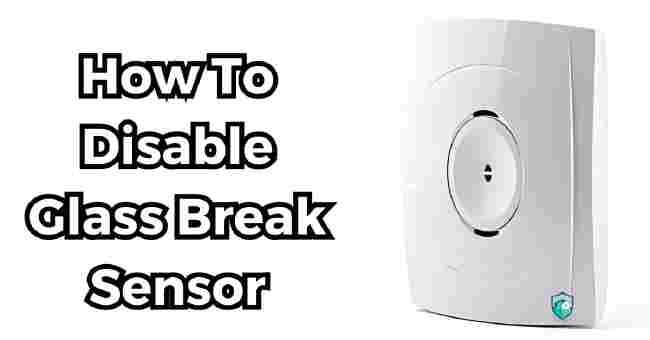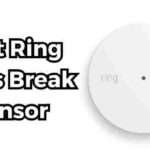Table of Contents
Do you wish to know how to disable glass break sensor? Yes, living in the age of smart home security, glass break sensors have become a popular, useful way to detect when an intruder gains access to your home.
These nifty devices listen for the sound frequencies produced when glass breaks, and alert you and/or proper authorities in the event your window or door is shattered.
While glass break sensors serve an important security purpose, you may find yourself needing to disable the device temporarily.
In this comprehensive guide, I’ll cover when and why you may need to disable your glass break sensor, walk through how to disable various sensor types, provide troubleshooting tips, and share safety precautions to follow.
When Do You Need to Disable a Glass Break Sensor?
Before jumping into the how of disabling a glass break sensor, it’s important to understand the why.
There are several legitimate reasons you may need to temporarily shut off this component of your home security system:
- During renovations – If you’re replacing windows or doors in your home, the removal process could set off the glass break sensor alarm. Disabling it ahead of renovations will prevent false alarms.
- Addressing malfunctions – If your sensor is malfunctioning and producing false alarms, disabling it temporarily gives you a chance to troubleshoot the issue before the nonstop alarms drive you mad.
- Servicing and cleaning – To clean the glass surface near your sensor or make minor repairs, it’s wise to disable the device first. This avoids accidental alarm triggers while you’re working.
- Adjusting sensitivity – If your glass break sensor has adjustable sensitivity, you may wish to turn it off briefly while tweaking the settings to avoid false alarms during the process.
- Replacing old sensors – When swapping out old sensors for new ones, you’ll need to disable the original sensor before removing it to avoid sounding the alarm.
The key in each scenario is that the glass break sensor is only disabled temporarily – during the window of time when a false alarm is likely or while you’re adjusting its settings.
The device should be promptly reactivated once the task is complete.
Now let’s look at how to go about disabling your glass break sensor properly.
How to Disable Glass Break Sensor: Wireless
Many home security glass break sensors today are wireless, meaning they operate on battery power and communicate with the system’s control panel via radio signals instead of wires.
Here are the steps to temporarily disable common wireless glass break sensor models:
Step 1: Locate the Sensor
Wireless glass break sensors are typically mounted high on a wall or window/door frame in the vicinity of the glass surface they are monitoring. Locate yours visually first before moving on to disable it.
Step 2: Open the Battery Compartment
Most wireless glass break sensors have an exterior battery compartment secured with small screws or a latch mechanism.
Use a screwdriver to open the battery compartment lid and expose the batteries inside.
Step 3: Remove the Batteries
Once you gain access to the battery compartment, simply remove the batteries. This immediately cuts off the sensor’s power supply and disables it.
Step 4: Reinstall Batteries Later
When you’ve completed the task that required disabling the sensor, put the batteries back in place and close up the compartment to reactivate the device.
Test it to confirm the glass break sensor is functioning normally again.
And that’s all there is to it for most wireless glass break sensor models. By removing the power source altogether for a short time, you can keep the device from triggering unwanted alarms during any work around windows and glass doors.
How To Disable Glass Break Sensors: Wired
While wireless options prevail today, some older home security systems utilize glass break sensors that are physically wired to the alarm control panel.
Here’s how to safely disable these:
Step 1: Locate Sensor and Control Panel
Find the wired glass break sensor mounted near the window or door it monitors. Also locate the alarm system’s main control panel where the sensor’s wires terminate.
Step 2: Open Control Panel
The control panel will have a removable cover plate or access panel secured with screws. Use a screwdriver to remove these screws so you can access the interior wiring.
Step 3: Identify Sensor Wires
Inside the control panel, locate the two wires that connect to the glass break sensor you want to disable. They may be labeled something like “Window 1” or a similar identifier.
Step 4: Disconnect Wires
Using needle nose pliers, gently detach the two sensor wires from their terminals on the control panel circuit board. This breaks the electrical connection and disables that sensor.
Step 5: Reconnect Wires Later
Once your task is complete, reconnect the sensor wires to the proper terminals on the control panel circuit board to reactivate the glass break sensor.
Secure the access panel cover again before testing the sensor.
By disconnecting the sensor’s wires at the alarm panel, you can temporarily take wired glass break sensors offline without having to remove the physical device itself in most cases.
Troubleshooting Glass Break Sensor Malfunctions
While every home security device is vulnerable to technical issues, glass break sensors do tend to malfunction more than other components.
False alarms, failures to detect glass breaks, and other operational problems can arise.
Here are some tips to troubleshoot and solve common glass break sensor issues:
Problem: False alarms, sensor alarm activates without any glass break event
Potential Causes:
- Loose wiring connection
- Low batteries
- Sensor mounted too close to noise source
- Sensitivity set too high
Solutions:
- Check wiring connections at sensor and panel
- Install fresh batteries in wireless sensors
- Move sensor away from potential noise/vibration sources
- Adjust sensitivity settings to lower level
Problem: Sensor fails to detect actual glass breaks
Potential Causes:
- Dead batteries in wireless sensors
- Physical blockage of sensor microphone
- Sensitivity set too low
- Wiring disconnection in wired sensors
Solutions:
- Replace batteries in wireless sensors
- Clean microphone port/remove obstructions
- Adjust sensitivity settings to higher level
- Check for disconnected wires at sensor and panel
Problem: Sensor produces false alarms intermittently
Potential Causes:
- Interference from other wireless devices
- Low batteries about to die
- Temporary noise/vibration near sensor
Solutions:
- Change wireless channel/frequency
- Install fresh batteries as preventive measure
- Observe to isolate noise source and move sensor away
With some diligent troubleshooting and process of elimination, you can typically resolve any glass break sensor malfunctions that arise and restore normal operation.
Adjusting Glass Break Sensor Sensitivity
As noted in the troubleshooting section above, improper sensitivity settings can lead to both false alarms and failures to detect genuine glass breaks.
Here are some pointers on adjusting sensor sensitivity properly:
- Most glass break sensors have DIP switches or digital settings to alter detection sensitivity levels. The user manual will explain adjustment procedures specific to your model.
- Higher sensitivity settings make the sensor more easily triggered, while lower settings raise the sound frequency threshold to activate an alarm.
- Start at the middle or moderate factory default setting, then tweak up or down gradually based on performance.
- After adjusting sensitivity, walk test the sensor by breaking glass samples at varying distances to confirm desired performance.
- Try to find the sweet spot for sensitivity – high enough to detect real glass breaks, but low enough to avoid frequent false alarms.
Getting the sensitivity adjusted correctly goes a long way in making sure your glass break sensor functions as intended. Take time to test and dial it in just right.
Safely Removing Old Glass Break Sensors
As home security systems age and technology advances, you may eventually want to swap out old glass break sensors for newer models.
Here are some tips for safe, effective sensor removal when the time comes:
- Always disable the current glass break sensor first, following the steps earlier in this article based on your wired or wireless model.
- If wired, disconnect the sensor wires from the terminals on the alarm system control panel.
- Remove any mounting screws to detach the old sensor from the wall/window frame.
- Unplug the sensor connector cable from the back of the device if applicable.
- For adhesive mounts, carefully pull the sensor free from the mounting surface. Use a plastic putty knife to help lift adhesive mounts.
- Once removed, you can install the new, upgraded glass break sensor in its place on the wall or window.
- Reconnect wires to the control panel or insert batteries in the new sensor to power it up.
- Test the replacement sensor thoroughly and adjust settings as needed before relying on it to monitor glass breaks.
With some careful preparation and work, swapping glass break sensors doesn’t have to be a difficult endeavor. Just take your time and follow safety precautions.
Safety Tips When Disabling Glass Break Sensors
While today’s glass break sensor technology makes disabling the devices fairly straightforward in most cases, there are still some safety precautions to keep in mind:
- Always put your home alarm system in complete disarm/disable mode prior to disabling any individual sensor.
- When working with wired sensors, turn off power to the alarm panel at the main circuit breaker panel before disconnecting wires.
- Use insulated tools when dealing with the wiring connections.
- Take care not to touch exposed wire ends or other electrical connections.
- Use caution on ladders when accessing wired alarm panels mounted high on walls or ceilings.
- Follow manufacturer’s instructions closely, particularly when manipulating components like removal sensors.
- Return any disabled sensors to active mode promptly once your work is completed. Never leave a sensor disabled indefinitely.
While glass break sensors are relatively low voltage, it’s still wise to exercise caution and care when handling wires and electrical connections during the disabling process.
Frequently Asked Questions About Disabling Glass Break Sensors
Below are answers to some of the most common questions homeowners have about temporarily disabling their glass break sensors:
How long can I safely keep my glass break sensor disabled?
Glass break sensors should only be disabled temporarily during the specific window of time when false alarms are probable.
Leave sensors disabled for the minimum time necessary. Reactivate them promptly when the risk of false alarms ends. Never leave them disabled indefinitely.
Will disabling the glass break sensor disable my whole alarm system?
Disabling an individual glass break sensor will not disable your entire home security system.
However, you should put your overall system into disarmed mode when working on any one component to avoid unintended alarms.
Do I need any special tools to disable my glass break sensor?
For wireless sensors, usually just a basic screwdriver to access the battery compartment.
For wired sensors, you may need a screwdriver, needle nose pliers, and wire cutters. Refer to your user manual for any model-specific tools needed.
Is it difficult to reactivate my sensor after disabling?
Reenabling your glass break sensor is quite simple. Just replace the batteries or reconnect the wires you detached during disabling.
In most cases, power restoration is all that’s required to reactivate the sensor.
What’s the average cost to replace a malfunctioning glass break sensor?
Prices can range from $50 to $250+ depending on the brand, features, and underlying technology.
Simpler wireless sensors tend to cost less than sophisticated wired units. Professional installation also adds to replacement cost.
Conclusion
Glass break sensors certainly aren’t the most essential component in a home security system, but they do offer an added layer of protection against intrusions.
Hopefully this guide gave you a thorough understanding of when and how to disable your glass break sensors, as well as tips for troubleshooting, adjusting sensitivity, and replacing faulty units.
While the process varies slightly across wired and wireless models, disabling glass break sensors is straightforward when done carefully.
Just follow safety precautions, and never leave a sensor disabled indefinitely.
With this knowledge in hand, you can confidently manage this piece of your home security system and keep it running smoothly for years to come.





Pingback: How To Remove Glass Break Sensor Cover: 3 Steps Each -